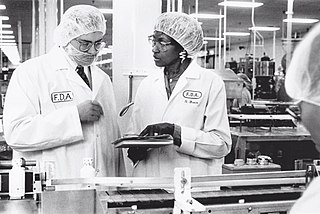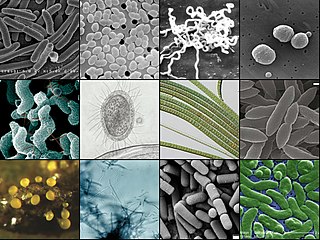
An antibiotic is a type of antimicrobial substance active against bacteria. It is the most important type of antibacterial agent for fighting bacterial infections, and antibiotic medications are widely used in the treatment and prevention of such infections. They may either kill or inhibit the growth of bacteria. A limited number of antibiotics also possess antiprotozoal activity. Antibiotics are not effective against viruses such as the common cold or influenza; drugs which inhibit growth of viruses are termed antiviral drugs or antivirals rather than antibiotics. They are also not effective against fungi; drugs which inhibit growth of fungi are called antifungal drugs.

Sir Alexander Fleming was a Scottish physician and microbiologist, best known for discovering the world's first broadly effective antibiotic substance, which he named penicillin. His discovery in 1928 of what was later named benzylpenicillin from the mould Penicillium rubens is described as the "single greatest victory ever achieved over disease." For this discovery, he shared the Nobel Prize in Physiology or Medicine in 1945 with Howard Florey and Ernst Boris Chain.

A medication is a drug used to diagnose, cure, treat, or prevent disease. Drug therapy (pharmacotherapy) is an important part of the medical field and relies on the science of pharmacology for continual advancement and on pharmacy for appropriate management.

Streptomycin is an antibiotic medication used to treat a number of bacterial infections, including tuberculosis, Mycobacterium avium complex, endocarditis, brucellosis, Burkholderia infection, plague, tularemia, and rat bite fever. For active tuberculosis it is often given together with isoniazid, rifampicin, and pyrazinamide. It is administered by injection into a vein or muscle.

Gerhard Johannes Paul Domagk was a German pathologist and bacteriologist. He is credited with the discovery of sulfonamidochrysoidine (KL730) as an antibiotic for which he received the 1939 Nobel Prize in Physiology or Medicine. The drug became the first commercially available antibiotic and marketed under the brand name Prontosil.

Sulfonamide is a functional group that is the basis of several groups of drugs, which are called sulphonamides, sulfa drugs or sulpha drugs. The original antibacterial sulfonamides are synthetic (nonantibiotic) antimicrobial agents that contain the sulfonamide group. Some sulfonamides are also devoid of antibacterial activity, e.g., the anticonvulsant sultiame. The sulfonylureas and thiazide diuretics are newer drug groups based upon the antibacterial sulfonamides.

The pharmaceutical industry discovers, develops, produces, and markets drugs or pharmaceutical drugs for use as medications to be administered to patients, with the aim to cure them, vaccinate them, or alleviate symptoms. Pharmaceutical companies may deal in generic or brand medications and medical devices. They are subject to a variety of laws and regulations that govern the patenting, testing, safety, efficacy using drug testing and marketing of drugs. The global pharmaceuticals market produced treatments worth $1,228.45 billion in 2020 and showed a compound annual growth rate (CAGR) of 1.8%.
The year 1932 in science and technology involved some significant events, listed below.

Prontosil is an antibacterial drug of the sulfonamide group. It has a relatively broad effect against gram-positive cocci but not against enterobacteria. One of the earliest antimicrobial drugs, it was widely used in the mid-20th century but is little used today because better options now exist. The discovery and development of this first sulfonamide drug opened a new era in medicine, because it greatly widened the success of antimicrobial chemotherapy in an era when many physicians doubted its still largely untapped potential. At the time, disinfectant cleaners and topical antiseptic wound care were widely used but there were very few antimicrobial drugs to use safely inside living bodies. Antibiotic drugs derived from microbes, which we rely on heavily today, did not yet exist. Prontosil was discovered in 1932 by a research team at the Bayer Laboratories of the IG Farben conglomerate in Germany.

Friedrich Carl Duisberg was a German chemist and industrialist.
In microbiology, the minimum inhibitory concentration (MIC) is the lowest concentration of a chemical, usually a drug, which prevents visible growth of a bacterium or bacteria. MIC depends on the microorganism, the affected human being, and the antibiotic itself. It is often expressed in micrograms per milliliter (μg/mL) or milligrams per liter (mg/L).

Sulfanilamide is a sulfonamide antibacterial drug. Chemically, it is an organic compound consisting of an aniline derivatized with a sulfonamide group. Powdered sulfanilamide was used by the Allies in World War II to reduce infection rates and contributed to a dramatic reduction in mortality rates compared to previous wars. Sulfanilamide is rarely if ever used systemically due to toxicity and because more effective sulfonamides are available for this purpose. Modern antibiotics have supplanted sulfanilamide on the battlefield; however, sulfanilamide remains in use today in the form of topical preparations, primarily for treatment of vaginal yeast infections mainly vulvovaginitis which is caused by Candida albicans.

The disk diffusion test is a culture-based microbiology assay used in diagnostic and drug discovery laboratories. In diagnostic labs, the assay is used to determine the susceptibility of bacteria isolated from a patient's infection to clinically approved antibiotics. This allows physicians to prescribe the most appropriate antibiotic treatment. In drug discovery labs, especially bioprospecting labs, the assay is used to screen biological material and drug candidates for antibacterial activity. When bioprospecting, the assay can be performed with paired strains of bacteria to achieve dereplication and provisionally identify antibacterial mechanism of action.
2-Oxazolidone is a heterocyclic organic compound containing both nitrogen and oxygen in a 5-membered ring.

Medical microbiology, the large subset of microbiology that is applied to medicine, is a branch of medical science concerned with the prevention, diagnosis and treatment of infectious diseases. In addition, this field of science studies various clinical applications of microbes for the improvement of health. There are four kinds of microorganisms that cause infectious disease: bacteria, fungi, parasites and viruses, and one type of infectious protein called prion.

Thomas Hager is an American author of popular science and narrative nonfiction.

Bayer AG is a German multinational pharmaceutical and biotechnology company and one of the largest pharmaceutical companies in the world. Headquartered in Leverkusen, Bayer's areas of business include pharmaceuticals; consumer healthcare products, agricultural chemicals, seeds and biotechnology products. The company is a component of the EURO STOXX 50 stock market index.

Stuart Blank Levy was a researcher and physician at Tufts University. He was among the first to advocate for greater awareness of antibiotic resistance and founded the Alliance for the Prudent Use of Antibiotics.

A bacteriologist is a microbiologist, or similarly trained professional, in bacteriology -- a subdivision of microbiology that studies bacteria, typically pathogenic ones. Bacteriologists are interested in studying and learning about bacteria, as well as using their skills in clinical settings. This includes investigating properties of bacteria such as morphology, ecology, genetics and biochemistry, phylogenetics, genomics and many other areas related to bacteria like disease diagnostic testing. Alongside human and animal healthcare providers, they may carry out various functions as medical scientists, veterinary scientists, or diagnostic technicians in locations like clinics, blood banks, hospitals, laboratories and animal hospitals. Bacteriologists working in public health or biomedical research help develop vaccines for public use.

Bartolomeo Gosio was an Italian medical scientist. He discovered a toxic fume, eponymously named "Gosio gas", which is produced by microorganisms, that killed many people. He identified the chemical nature of the gas as an arsenic compound (arsine), but incorrectly named it as diethylarsine. He also discovered an antibacterial compound called mycophenolic acid from the mould Penicillium brevicompactum. He demonstrated that the novel compound was effective against the deadly anthrax bacterium, Bacillus anthracis. This was the first antibiotic compound isolated in pure and crystallised form. Though the original compound was abandoned in clinical practice due to its adverse effects, its chemical derivative mycophenolate mofetil became the drug of choice as an immunosuppressant in kidney, heart, and liver transplantations.

















